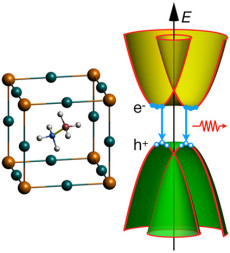Revealing Reclusive Recombination Mechanisms in Solar Cell Materials
Researchers used NERSC supercomputers to better understand the solar conversion efficiencies of hybrid perovskites
January 2, 2019

Strong spin-orbit coupling in halide perovskites induces splitting of the band edges, which could affect recombination rates. Image credit: X. Zhang and J.-X. Shen.
This article used materials provided by the Van de Walle group at the University of California, Santa Barbara
Hybrid perovskites are spectacularly efficient materials for photovoltaics. Just a few years after the first solar cells were fabricated, they have already achieved solar conversion efficiencies greater than 22 percent. Interestingly, the fundamental mechanisms that are responsible for this high efficiency are still being vigorously debated.
A thorough understanding of these mechanisms is essential to enable further improvements, and computational studies conducted using the National Energy Research Scientific Computing Center (NERSC) at Lawrence Berkeley National Laboratory have produced critical new insights. Chris Van de Walle’s group at the University of California, Santa Barbara (UCSB) has reported these breakthroughs in two recent papers: X. Zhang, J.-X. Shen, W. Wang, and C. G. Van de Walle, ACS Energy Lett. 3, 2329 (2018) and J.-X. Shen, X. Zhang, S. Das, E. Kioupakis, and C. G. Van de Walle, Adv. Energy Mater. 8, 1801027 (2018).
Hybrid perovskites are a group of materials that combine organic molecules with an inorganic framework in a perovskite lattice structure. A number of research groups previously attributed the high efficiency of the hybrid perovskites to an indirect band gap originating from strong spin-orbit coupling. It was argued that the indirect nature of the gap suppresses radiative recombination between electrons and holes and thus minimizes undesirable carrier recombination. UCSB postdoc Xie Zhang and PhD student Jimmy-Xuan Shen (who has since graduated) demonstrated that this was incorrect by developing a cutting-edge, first-principles approach to accurately determine the spin texture of the band edges and quantitatively compute the radiative recombination rates. For methylammonium lead iodide (the prototype hybrid perovskite commonly referred to as MAPI) they found that the radiative recombination is actually as strong as in conventional direct-gap semiconductors.
“This result should put an end to misguided attempts to analyze and design device characteristics based on erroneous assumptions about the recombination rate,” said Zhang.
Strong radiative recombination means that these materials are also useful for light-emitting diode (LED) applications. However, current densities in LEDs are much higher than in solar cells, and at high carrier concentrations nonradiative recombination processes can become detrimental. Such nonradiative losses have been observed, but experimentally it is not possible to identify the microscopic origins. Shen and Zhang built on expertise in the Van de Walle group to accurately compute the recombination rate from first principles. They also managed to precisely link the rate to features in the electronic structure.
“Auger recombination is a process in which two carriers recombine across the band gap and the excess energy is transferred to a third carrier,” explained Shen. “We found that the Auger coefficient in MAPI is unexpectedly large: two orders of magnitude larger than in other semiconductors with comparable band gaps.”
The researchers identified two distinct features of the material that are responsible: a resonance between the band gap and the spin-orbit-induced splitting of the conduction bands, and the presence of structural distortions that promote the Auger process.
“These calculations are extremely demanding, and the compute power provided by NERSC has been instrumental in obtaining these results,” commented Van de Walle. “We have been able to demonstrate that Auger losses can be suppressed if lattice distortions are reduced, and we propose specific approaches for achieving this in real materials.”
NERSC is a DOE Office of Science User Facility.
About NERSC and Berkeley Lab
The National Energy Research Scientific Computing Center (NERSC) is a U.S. Department of Energy Office of Science User Facility that serves as the primary high performance computing center for scientific research sponsored by the Office of Science. Located at Lawrence Berkeley National Laboratory, NERSC serves almost 10,000 scientists at national laboratories and universities researching a wide range of problems in climate, fusion energy, materials science, physics, chemistry, computational biology, and other disciplines. Berkeley Lab is a DOE national laboratory located in Berkeley, California. It conducts unclassified scientific research and is managed by the University of California for the U.S. Department of Energy. »Learn more about computing sciences at Berkeley Lab.







